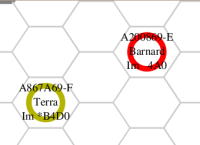Trade Map Key
Trade Map Key: This page is a key to the pdf sector trade maps included with some sectors. The maps are largely unadorned.
Trade Map Explanations[edit]
Each world is given a World Trade Number (WTN), a relative ranking of economic influence on outside worlds. It is based upon the world's population and starport. Larger worlds with poor starport facilities have less influence than smaller population worlds with better starports.
For each pair of worlds a Bilateral Trade Number (BTN) is calculated. This is a ranking of the volume of trade between these two worlds. It takes into account distances, allegiances of the worlds, and other economic factors. The BTN numbers on these maps range from 8 to 12, representing the most active routes.
Each world on the map is placed on a hex grid and given four lines of information.
- First Line: The first line is the Universal World Profile in standard format.
- Second Line: The second line is the world name.
- Third Line: The third line consists of:
- A two or four character Allegiance Code
- A + for a subsector or empire capital or a * for a sector capital world, or blank if neither.
- The count of Gas Giants in the system, typically between 0 and 5
- Fourth Line: The fourth line has a number with four digits These are:
- Digit #1. The world's WTN in e-hex format. The calculated WTN is doubled, as shown in the sector data file.
- Digit #2. The world's incoming and outgoing trade, as a BTN value in e-hex.
- Digit #3. The port's transient trade, as a BTN value in e-hex.
- Digit #4. The size of the port on the world. A log scale value from 0 (the smallest) to 7 (the largest) as generated from GURPS Traveller: Starports pg. 59.
The values of the incoming and transient trade BTN values can be converted back to credit values by looking up the value in the table on pg.16 of GURPS Traveller: Far Trader. As calculated there are no half steps (e.g. BTN 5.5).
Example #1:[edit]
- D78A302-A = Universal World Profile or UWP
- Bangwe = World name
- ImDd 2 = Allegiance (Domain of Deneb) + 2 gas giants
- 5083 = WTN (World Trade Number) + Incoming Trade (Imports/Exports) + Port Trade (Transient) + Port size (Starport)
Example #2[edit]
- C420774-7 = Universal World Profile or UWP
- Malory = World name
- ImDd 3 = Allegiance (Domain of Deneb) + 3 gas giants
- 8883 = WTN (World Trade Number) + Incoming Trade (Imports/Export) + Port Trade (Transient) + Port size (Starport)
Zoned World Explanations[edit]
Some worlds are marked with an amber or red circle.
- The Amber Zone worlds (...or Zhodani Unincorporated Worlds) have some cautionary element to them.
- The Red Zone worlds (...or Zhodani Forbidden Worlds) are forbidden to Traders.
- Trade Routes will avoid these worlds for this reason.
Trade Route Explanations[edit]
The trade routes on the map are shown as colored lines, each color representing a trade volume category.
If there is no line between two worlds, this means that there isn't enough trade to reach the BTN-8 requirements. There may or may not be a regularly scheduled ship or two between the worlds. One or two ships, probably free traders, provide service between the worlds. These worlds typically lack development and the better quality starports. They are often limited to extremely rudimentary Class E Starports or even system spaceports.
The red lines represent BTN-8 minor routes. These routes are the smallest which still have regularly scheduled traffic. Usually between four and eight small liners and an equal number of free traders ply this route, with a general average of one ship per day entering or leaving each port. As an average there is 1,000 dtons of cargo and 20 passengers per week.
The yellow lines represent BTN-9 feeder routes. These routes are served by the larger freighters, generally between four and eight, with an equal number of smaller liners and free traders. While only two to four ships per day leave or enter port, they are larger ships than on a BTN 8 route. As an average there is 10,000 dtons of cargo and 200 passengers per week along the route.
The green lines represent BTN-10 intermediate routes. These routes are served by twenty to forty freighters and a smaller number of liners and free traders. On average ten ships per day enter or leave port. As an average there is 100,000 dtons of cargo and 2,000 passengers per week along the route.
The cyan lines represent BTN-11 main routes. These routes see the use of the very large mega-freighters, and there are still dozens of smaller freighters and liners. There may be as many as 20 ships per day entering or leaving port. As an average there is one million dtons of cargo and 20,000 passengers per week along the route.
The blue lines represent BTN-12+ major routes. These routes are the largest and most active in all of charted space. A dozen mega-freighters and as many as 100 smaller ships regularly travel this route. There can be as many as 50 ships per day entering or leaving port. As an average there is ten million dtons of cargo and 200,000 passengers per week along the route.
Sector Economic Data Key[edit]
The trade generation system also calculates a number of additional data points for each world. This data is stored with each sector under the <sector page>/economic page. The infobox for the sector article also has a link the the "economic data" for the sector.
The columns of the data files and their meanings are as follow:
| Sector Economic Data Key | |
|---|---|
| Term | Remarks |
| Hex | Position in the sector |
| Name | Name of the world |
| UWP | Universal World Profile - Basic Statistics as copied from the generated values on TravellerMap |
| {Ix} | The Importance Extension, a ranking of the world as generated from the T5 Core Rules on pg. 411. |
| WTN | The World Trade Number as generated from GT: Far Trader, but multiplied by 2. So a listed WTN of 5 becomes WTN of 2.5 when referencing the table on pg. 16 of GURPS Traveller: Far Trader. |
| MSPR | Maximum sustainable population rating. A calculation of the maximum population of the world without technological assistance. If the world's population exceeds this, it is relying on technology to support them. |
| RU | Resource Units as generated from the Traveller 5: Worlds and Adventures on pg. 27 |
| Per Capita (Cr) | The average per-capita income for the world in credits. Generated per pg. 14 of GT:Far Trader. |
| GWP(MCr) | The Gross World Product (in MCr) as generated pg. 14 of GT:Far Trader. |
| Trade (MCr/year) | The volume of trade coming into and leaving the world in millions of credits per year. |
| Passengers | Number of passengers entering and leaving the world per year, as generated by the rules on pg. 17 of GT: Far Trader |
| Build | The theoretical shipyard capacity for construction of starships and spaceships. Capacity is listed in Tons, as generated from Trillion Credit Squadron |
| Army | The size of the standing army on the world measured in Battalion Equivalents (about 500 individuals eqiupped to the local TL standards), as generated from GURPS Traveller: Ground Forces |
| Port | The size of the port on the world. A log scale value from 0 (the smallest) to 7 (the largest) as generated from GURPS Traveller: Starports pg. 59. |
| SPA Population | Number of employees hired by Starport Authority (or local starport) to operate the port. Generated from GURPS Traveller: Starports pg. 65. |
| Trade Goods | The Trade goods string generated from Book 7: Merchant Prince indicating the type and price of goods available for speculative trade. |
References & Contributors (Sources)[edit]
- John Harshman, Marc Miller. Trillion Credit Squadron (Game Designers Workshop, 1981), .
- Steve Daniels, Jim McLean, Christopher Thrash. Far Trader (Steve Jackson Games, 1999), 14,16.
- John M. Ford, James D Maliszwski. Starports (Steve Jackson Games, 2000), 59,65.
- Douglas E. Berry. Ground Forces (Steve Jackson Games, 2000), .
- Marc Miller, Robert Eaglestone, Don McKinney. Worlds and Adventures (Far Future Enterprises, 2019), 27.







